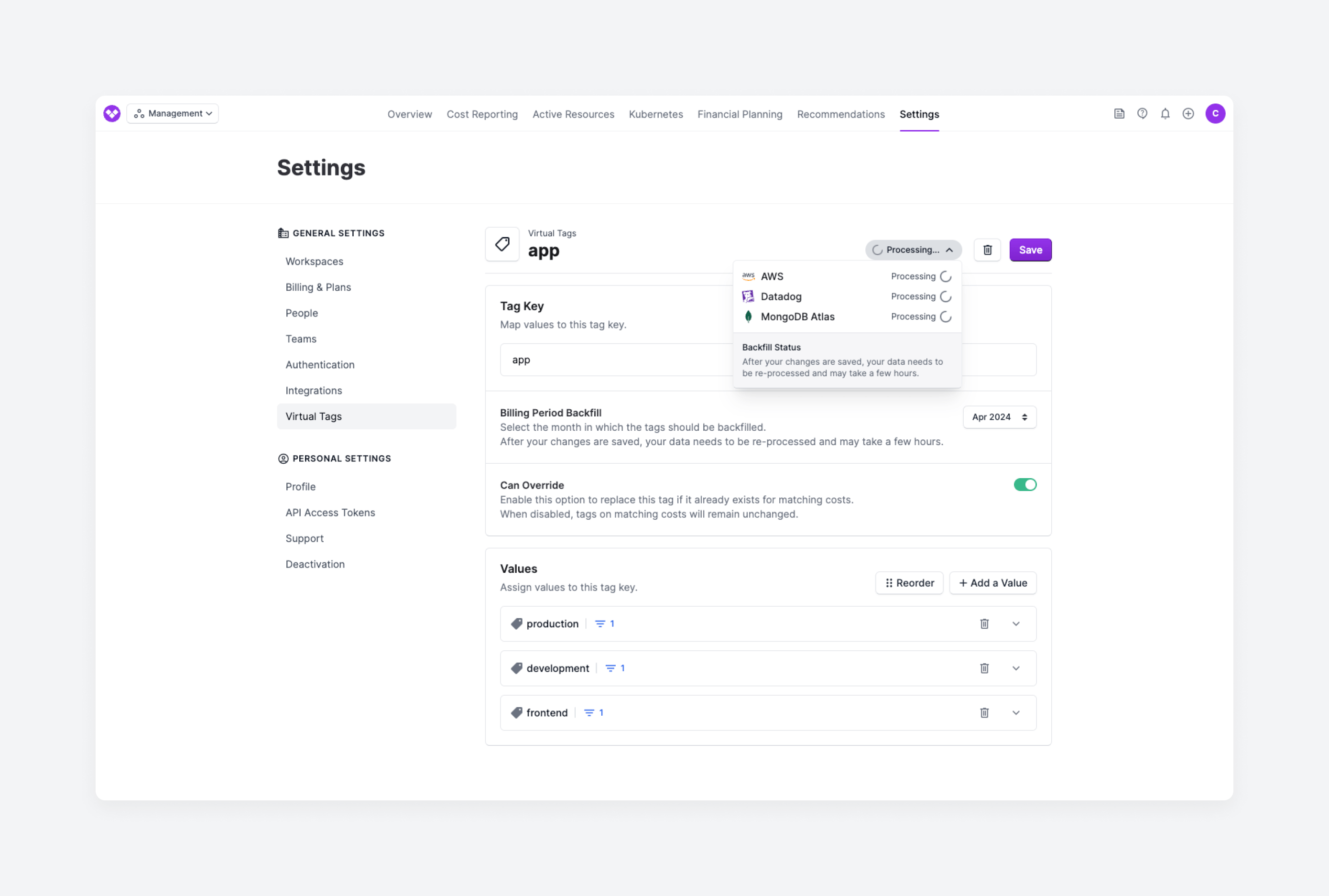Vantage Launches Virtual Tagging: The Ability to Create Custom Cost Allocation Tags
Vantage announces the launch of virtual tagging. Apply new cost allocation tags for cost data that is imported into Vantage, regardless of provider.

Today, Vantage announces the launch of virtual tagging: the ability to apply new cost allocation tags for cost data imported into Vantage. This feature makes it possible to add tags to providers who do not support them, increase tagging coverage for providers that do, and natively address any tagging discrepancies across providers within Vantage.
Previously, it was a challenge to maintain consistent tagging practices across an organization’s entire cloud infrastructure. Organizations often change or update their tagging schemas, which can be cumbersome to continuously manage within each cloud provider’s environment—especially since backfilling tag changes are not always supported and some providers do not support tagging at all. This inconsistency in tagging practices leads to discrepancies in cost data and makes it challenging to generate accurate reports within Vantage when tags are mismatched across dates and providers. In addition, tagging changes often require engineering teams to update their cloud infrastructure, which could delay a FinOps practitioner from being able to create various reports in a timely fashion.
Now, customers can create “virtual” cost allocation tag keys with a set of corresponding values directly in the Vantage platform without needing to involve their engineering team to make infrastructure changes. Under the new Virtual Tags section, which can be found under Account Settings, customers can define virtual tag keys and values with corresponding filters. When a cost line item from the infrastructure provider matches the filters set for virtual tags, that tag key and value will be applied to the corresponding line item. These tag keys and values will flow throughout Vantage to be used in cost reporting, cost allocation, and are available for grouping functionality across the platform.

Virtual Tags UI in the console
This feature is now available for all users. To get started, navigate to the Virtual Tags section and create your first tag key. For more information on how to manage tags within Vantage, see the documentation.
Frequently Asked Questions
1. What is being launched today?
Today, Vantage is launching the ability to create virtual tags, based on a set of filters, for all cost data that’s ingested into Vantage. This feature can be used to normalize tags across providers, tag provider data that does not support tags, and generally improve tagging coverage across the board. Once applied, these tags can be used inside of Cost Reports, cost allocation segments, and saved filters and appear like any other provider’s native cost allocation tag.
2. Who is the customer?
The customer is any Vantage user who needs to supplement their existing cost tags that are natively managed within cloud providers.
3. How much does this cost?
This feature is free to all users.
4. What is an example of a virtual tag I can create?
You can create a tag key, for example, called Team.
- Potential tag values might be mobile, data, etc.
- Each tag value is associated with a certain set of filters. For example:
- data could be filtered down to all costs related to Amazon Redshift and GCP BigQuery.
- mobile could be filtered down to related GCP projects and AWS accounts that the mobile team is responsible for.
- Each tag value has an order associated with that tag key that determines which tag value is assigned in cases where there are overlapping filters.
5. Which providers are supported?
All provider integrations in Vantage are supported, including providers that do not natively support tags.
6. What types of filters can I apply for virtual tag values?
Any filter that can be applied to a Cost Report can be applied to a tag value filter.
7. How does the order of the virtual tag values work?
Tag values are arranged in priority order. You can move tag values up and down in the UI to reorder them.
When ingesting cost data into the Vantage platform, the first value that matches the corresponding filters will be applied to that line item. In cases where filters overlap, the order of tag values within each key determines the value that is applied.
8. When are virtual tags applied?
Tags are applied when new data is ingested. For each tag key, you can specify a billing period for which the tags will be backfilled. When you save any changes to a tag key, the data will be re-tagged back to the specific billing period. A “data processing” status will be displayed in the banner of the tag key page.
9. Where are virtual tags visible in the UI?
These tags are available for filtering and aggregating within all cost and segment reports, on the “Tag” filter and the “Tag” grouping. They can also be used in filters within saved filters.
10. Can I use saved filters when defining a virtual tag filter?
Not at this time.
11. Can I remove a tag from my data?
Not at this time; however, this feature is on our roadmap.
12. Can I rename an existing provider’s tag?
Not at this time; however, this feature is on our roadmap.
13. Is there a limit to the number of virtual tags I can define?
There is currently no limit to the number of tag keys or values that can be defined.
14. Can I manage these tags through the API?
Yes, the /virtual_tag_configs API endpoint is available to view, create, update, and delete virtual tags. For example, to create a virtual tag, send the following request:
15. What roles can manage tags?
Users with the Owner role can manage these tags.
16. Can virtual tags be used to group multiple provider tags into the same tag?
Yes, within a tag value filter, you can match existing provider tags. This could be useful if you have different spelling mistakes or different variations across providers. The existing tags will continue to exist alongside the virtual tag.
17. Can I apply virtual tags to specific active resources?
Not at this time.
18. What happens if a virtual tag key conflicts with an existing tag from a cost provider?
When you create a tag key, there is an option to override existing tag keys or to not tag incoming data that already has a tag value set for that key.
19. Are virtual tags included when I export a Cost Report?
Yes, virtual tags are included, like other cost allocation tags.
20. How should I think about how Virtual Tags, Saved Filters, and Segments mix with one another?
Virtual tags should be considered foundational to the rest of the data within Vantage. They should remain fairly static, and changes should be considered delicate. These changes will flow across all data and apply to all workspaces. The most common tag keys will be items like team, cost center, and environment.
Segments can then be used to create different hierarchical views for tagged data. This feature is useful for breaking down the data by different perspectives, such as by cost center or by OPEX/CapEX.
Saved filters can then be used in a more ad-hoc fashion to add lenses on top of base data. For instance, you could create a saved filter just for North America that standardizes a set of regions across providers and can be used by teams on their reports or dashboards without having to know the set of filters needed to create the list of regions. When new regions come online, it’s easy to modify the saved filter to include this region.
If you would like to transition any existing segments to virtual tags, our support team can automate this for you. You can reach out to support@vantage.sh to work with our team.
21. What happens when I delete a virtual tag?
Data will be re-tagged, excluding the deleted virtual tag, going back to that tag’s backfill billing period. Newly ingested data will no longer be tagged with this key.
22. Is there a way to preview my virtual tag filters on real data?
Not at this time, but we understand the importance of this experience, and it is something we are exploring.
23. How long do I need to wait after I create a new virtual tag filter to see it applied to my cost data?
Processing the tag changes usually takes under an hour, and the status will be displayed on the tag key page. Processing times vary on the number of tags and volume of data you have imported into Vantage.
Sign up for a free trial.
Get started with tracking your cloud costs.

